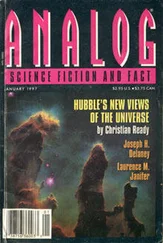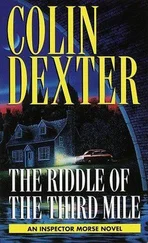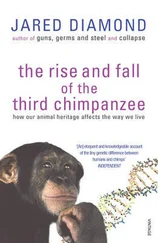Alexis Gilliland - The Third Wave
Здесь есть возможность читать онлайн «Alexis Gilliland - The Third Wave» весь текст электронной книги совершенно бесплатно (целиком полную версию без сокращений). В некоторых случаях можно слушать аудио, скачать через торрент в формате fb2 и присутствует краткое содержание. Год выпуска: 1995, Издательство: Dell Magazines, Жанр: Фантастика и фэнтези, на английском языке. Описание произведения, (предисловие) а так же отзывы посетителей доступны на портале библиотеки ЛибКат.
- Название:The Third Wave
- Автор:
- Издательство:Dell Magazines
- Жанр:
- Год:1995
- ISBN:нет данных
- Рейтинг книги:5 / 5. Голосов: 1
-
Избранное:Добавить в избранное
- Отзывы:
-
Ваша оценка:
- 100
- 1
- 2
- 3
- 4
- 5
The Third Wave: краткое содержание, описание и аннотация
Предлагаем к чтению аннотацию, описание, краткое содержание или предисловие (зависит от того, что написал сам автор книги «The Third Wave»). Если вы не нашли необходимую информацию о книге — напишите в комментариях, мы постараемся отыскать её.
The Third Wave — читать онлайн бесплатно полную книгу (весь текст) целиком
Ниже представлен текст книги, разбитый по страницам. Система сохранения места последней прочитанной страницы, позволяет с удобством читать онлайн бесплатно книгу «The Third Wave», без необходимости каждый раз заново искать на чём Вы остановились. Поставьте закладку, и сможете в любой момент перейти на страницу, на которой закончили чтение.
Интервал:
Закладка:
“Very good?” Levsky looked dubious. “NO! This is too fancy, too baroque.They should have stuck with the original plan, using iron pipe!”
“What are you ranting about? Originally they were going to use iron pipe because iron was dirt cheap. On parts of the lunar surface you can pick up iron with a magnet,” Winslow rubbed his chin. “Aluminum needs to be refined, and the sapphire whiskers need to be grown, yes. But machines are doing all of those things. The aluminum composite is better, and it is cheaper because it needs less labor input.”
Levsky sighed and shook his head.
“How is my government to project national power, to display will, machismo, heroism, when an objection based on mere cost accounting is treated as if it was serious?”
“What is your complaint? Or your government’s complaint? We are ahead of schedule and under budget.”
“In some circles there is resistance to giving up the national armamentarium,” said the colonel at last. “The prototype is moving along wonderfully, yes, but the true starship, the one we shall build after the prototype, that, my friend, may never be launched.”
The train of modules encased in the six recoil tracks moved slowly back to battery, the starting place where it would stand when the first hydrogen bomb was exploded in the vast reaction chamber. Appearances were deceiving; the tracks, together with the modules, now fully loaded, had about the same mass as the great, geodesic hemisphere that formed the reaction chamber. The two parts of the system were moving in equal and opposite directions, but the human eye, looking at the huge, shining hemisphere compared it with the comparatively insignificant train of modules, and attributed all motion to the train of modules.
“A pity we can’t fire a test charge or two,” said Morgan, the former Navy test pilot detailed from NASA via the United Nations to command the prototype starship. “It goes back easily enough.”
“The total mass is 112,850 tons,” said Colonel P.I. Levsky. “Once it starts moving, stopping it is going to be a bitch. Or do I mean “son of a bitch?” Your idiomatic expressions are confusing at times.”
“Either is correct,” replied Morgan easily. “Though bitch conforms to current usage.” He sighed. “What a pity they won’t let us do a little practical testing before we take that hot, hot motor out for its trial run.”
“The world has been doing test runs on the propulsion system since 1945,” observed Dr. Sioux Kerry. “You can’t blame the general public for not wanting to let the experts play with their oh, so dangerous toys any more than is absolutely necessary.”
“Don’t worry about it,” said Madeline Tosca. “The engineering is quite conservative. One of the things the prototype will do is show us what we can cut.”
“The recoil rails are overbuilt,” Morgan agreed. “While the support for the modules… you might be able to drop the gross weight by 10 percent.”
“That will be decided when we have the engineering data that the prototype will provide,” said Dr. Kerry. “In the meantime, I have got to establish the biosphere we want to take.”
A timer sounded. The modules had returned to their original position. “It’s 18:32.6!” said Morgan with satisfaction. “That means that we don’t have to start reloading the chamber from the magazine until we have a full stop. All right!”
“When are we going to start?” asked the Russian.
“When we’re ready, of course, Colonel Levsky. But it will be soon, now. Days, rather than weeks.”
The estimate of “days” was optimistic, but soon, soon thereafter the prototype starship slipped its moorings, pushing itself slowly away from Lunar Three under the impetus of mass drivers mounted on tiny space tugs. When the prototype was properly aligned and on the far side of the Moon from Earth, the main engine was started, firing one hydrogen bomb every half hour, as the voyage to Diomedes got underway.
Thirty-four days later, at the end of what proved to be a routine trip, Captain Morgan detonated a fifty-kiloton squib in the giant reaction chamber, to match velocities with the planifitesimal Cowflop at a distance of just under a kilometer. When the prototype starship had converted itself to “Diomedes Station I” it looked like a great mirrored bowl pointing at the Sun. Inside the bowl was the heat engine driven by sunlight, and behind the bowl was the torus of modules that enclosed the biosphere. To provide gravity, the torus was spun in one direction, while the bowl and heat engine were spun in the other. The whole assembly was balanced on three of the unshipped recoil rails, which were firmly grounded on Cowflop’s newly arrived industrial complex. One rail sat on the dust sorting mill and chemical plant, the other two sat on the steel plant and the glass and aluminum plant, respectively.
The leadership council met in the module that now sat next to the cafeteria end of the crew quarters module. There was light, air, and a fair approximation of normal gravity. On the wall was a poster of Cowflop, and on the table was a model of the newly reconfigured space station. “We seem to be set up, more or less,” said Madeline Tosca, checking the light setting on her videocamera. “Now what?”
“We have these questions from the ‘MacArthur-Levine News Hour,’ said Hewlitt Morgan. “They’ve been in—I guess you could call it e-mail—contact with us for the past couple of days. Anyway, they’ve scripted out the result, and we’re supposed to read our answers.”
“What’s the point?” asked Winslow.
“Human interest translates into public support for the project,” said Sioux Kerry. “Read the first question.”
“Supposedly this will be Morton Levine speaking,” said Morgan. “He’s going to congratulate us for making history and segue to the question: “Now that the Dyson’s Dream has successfully landed, what are you going to do?”
“Start making stuff,” Colonel’s Levsky offered. “Steel wire, aluminum slurry billets, glass ingots. We get the raw materials on hand, we can figure out how to use them later.”
“Can we edit him out?” asked Dr. Sioux Kerry from the other end of the table. “I’d like to take the question.”
“Go ahead,” said Morgan.
“Thank you,” she replied. “We begin by enlarging our biosphere, which means expanding into the pressurized, gravitized and illuminated modules right here in Diomedes Station. Why? At normal consumption rates our food stores will be exhausted in about three months, and there is no prospect of resupply. Either we feed ourselves or starve.”
“The lady has a point,” Levsky said at last. “And perhaps she should expand on it. What will it take to expand this cramped and inadequate biosphere of ours?”
“Start with water,” Dr. Kerry replied. “Then dirt. We’ll have to make the dirt.”
“You have a recipe?”
“I have several, Winslow, but we’re starting with water. We’ll fill up the fish tanks, adjust the pH, and let the water come to equilibrium with the aquatic plants. Then we introduce the fish, and feed them all that single cell cr—protein that gets rendered out of the digestors.”
“That pretty much covers the first question, I guess. Then Levine wants to know: ‘What’s the worst news you’ve discovered for the starship, proper?’
“That would be me, again,” said Dr. Kerry. “In thirty-four days of hard traveling we lost about half the chickens. No way are they going to make it through a longer trip.”
Morgan nodded. “What was wrong with them?”
“They were dying is what was wrong. Figure that on a real trip to the stars you’ll be accelerating for years instead of weeks, and you can scratch the chickens.”
Читать дальшеИнтервал:
Закладка:
Похожие книги на «The Third Wave»
Представляем Вашему вниманию похожие книги на «The Third Wave» списком для выбора. Мы отобрали схожую по названию и смыслу литературу в надежде предоставить читателям больше вариантов отыскать новые, интересные, ещё непрочитанные произведения.
Обсуждение, отзывы о книге «The Third Wave» и просто собственные мнения читателей. Оставьте ваши комментарии, напишите, что Вы думаете о произведении, его смысле или главных героях. Укажите что конкретно понравилось, а что нет, и почему Вы так считаете.












